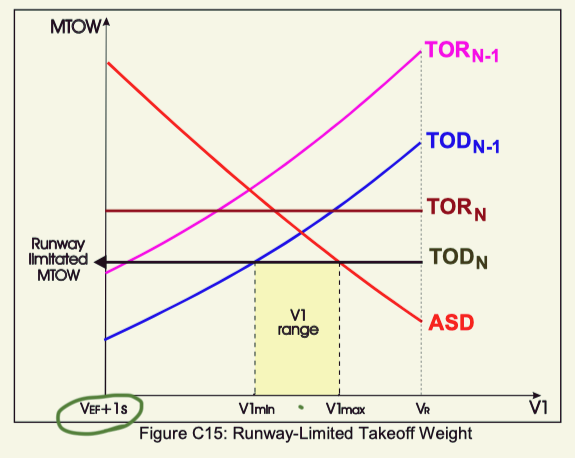Disclaimer:
▪︎This content is Not an official document and does not represent the views of Airbus or any other aviation authority.
▪︎The information provided may be incorrect or misinterpreted and should not be relied upon for decision-making.
▪︎Always refer to official documents and consult with a qualified aviation professional before making any decisions based on the information provided in this blog post.
▪︎The information provided in this blog post is based on personal study and review.
Accelerated Stop Distance
In theory, if we had an unlimited runway length, pilots could reject takeoff at any speed below rotation speed in case of any abnormalities before rotation. This assumes we're not considering factors like maximum brake energy speed and maximum tire speed.
This would be possible because the aircraft could stop at any point using the unlimited length of paved runway. It could roll at high speed and stop when necessary. If this scenario were feasible, V1 (decision speed) could simply be just below rotation speed, allowing the pilot to reject takeoff at any time before rotation.
However, in reality, runways are always limited in length, and aircraft require a certain distance to stop. Therefore, the decision speed (V1) must be reduced. This reduction is necessary to accommodate the required distance for an accelerated stop. This distance is known as the Accelerated Stop Distance (ASD). Since the ASD is limited, V1 needs to be adjusted accordingly. This is why ASD includes the length of the stopway if the runway has one.


Takeoff Distance
Now, consider what happens when V1 is reduced to a very low speed. When taking off in a limited length of runway, V1 must be reduced, and the pilot must be alert after reaching V1. For example, if V1 is set at 100 knots while Vr (rotation speed) is 140 knots, there might be enough distance to stop in case of a rejected takeoff at 99 knots.
However, if an abnormal situation occurs after reaching 100 knots, the pilot needs to accelerate the aircraft from 100 knots to 140 knots with only one engine operational, which also requires additional distance.
This distance is known as the 'Takeoff Distance'.
Additionally, the aircraft also requires distance to become airborne. In regulatory terms, takeoff distance usually refers to the distance required to climb to 35 feet above the takeoff surface.
If there are obstacles along the takeoff path, they cannot be considered as part of the available takeoff distance. Conversely, if there are no obstacles and certain conditions are met, that area can be considered as a clearway,
and the available takeoff distance can include the clearway.
(There is a difference between takeoff distance and takeoff run, but let's not delve too deeply into it)


In summary, the higher the V1, the shorter the takeoff distance will be. This is because with a higher V1 speed, the phase of all engine acceleration is longer, allowing the aircraft to achieve the same V2 speed at 35 feet in a shorter distance in case of an engine failure occurring at VEF. Conversely, a lower V1 results in a longer takeoff distance.
Ultimately, there exists a V1 speed where the takeoff distance available matches the stop distance available, and this is known as the balanced V1.

The influence of V1 on the Runway Limited Takeoff Weight
A higher V1 results in a longer ASD, limiting the maximum takeoff weight of the aircraft.
Conversely, a lower V1 limits the maximum takeoff weight by the takeoff distance.
This relationship is depicted in a graph where MTOW is limited by both ASD and TOD.
In a limited runway scenario, the MTOW will be limited by ASD in the high V1 range and by TOD in the low V1 range.

This Graph doesn't mean that the higher the V1, the ASD is low.
Remember, the vertical line of the graph represents MTOW, not the distance.
It indicates that MTOW is limited by ASD in the high V1 range, so the area below this red ASD line means that takeoff is not limited by ASD.
So, this graph indicates that MTOW will be limited due to the limited runway length.
Therefore, V1 should be within a certain limit because of the restricted MTOW imposed by the runway length.
Reference.
Getting to grips with Performance.
https://safetyfirst.airbus.com/control-your-speed-at-take-off/
Disclaimer:
▪︎This content is Not an official document and does not represent the views of Airbus or any other aviation authority.
▪︎The information provided may be incorrect or misinterpreted and should not be relied upon for decision-making.
▪︎Always refer to official documents and consult with a qualified aviation professional before making any decisions based on the information provided in this blog post.
▪︎The information provided in this blog post is based on personal study and review.
'KNOWLEDGE' 카테고리의 다른 글
| The location of the Aiming point marker (3) | 2024.03.28 |
|---|---|
| Coriolis Effect on Final (2) | 2024.03.05 |
| Runway Illusion (0) | 2024.03.03 |
| How to Identify the RNP routes in Jeppesen Manual (1) | 2024.01.21 |
| Contingency procedure in Oceanic and China (2) | 2024.01.17 |



